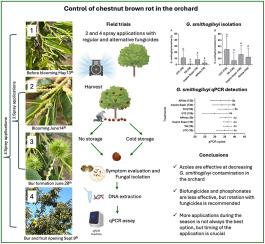Field evaluation of chemical and biological products to control chestnut brown rot caused by Gnomoniopsis smithogilvyi in Michigan
IF 2.5
2区 农林科学
Q1 AGRONOMY
引用次数: 0
Abstract
Gnomoniopsis smithogilvyi causes chestnut brown rot (CBR) which is responsible for the decay of chestnuts and is threatening the sustainability of the global chestnut market. The pathogen infects the flowers in the field, with symptoms affecting nut quality at harvest time and during storage. For this reason, cultural and chemical management is crucial to prevent infection in the flowers and later in the kernels. Michigan is the leading producer of commercial chestnuts in the United States. After the first isolation of the pathogen in 2016, CBR was identified in 80 % of Michigan orchards. This study aims to compare the efficacy of different fungicides and alternative fungicides to control CBR in orchards. Applications with six different active ingredients (propiconazole, tebuconazole, difenoconazole + azoxystrobin, potassium phosphonate, zinc phosphonate and Bacillus subtilis) were conducted for two consecutive years in 2023 and 2024, with two and four crown sprays between bloom and harvest. Zinc phosphonate was the most effective treatment based on qPCR assay for the pathogen detection, together with difenoconazole and propiconazole. No differences were found between two and four applications during the season, supporting the hypothesis of field applications during bloom as the most efficient strategy to control CBR. Chestnut fruits were healthy for human consumption, with no fungicide residues at harvest time. According to our findings, growers may use the selected fungicides (such as propiconazole and difenoconazole) and alternative fungicides (like K or Zn phosphonates) to complement their field practices for CBR control, encouraging the rotation between different active ingredients.

密歇根州栗褐腐病化学与生物防治产品的田间评价
栗褐腐病(CBR)是栗子腐烂的主要原因,威胁着全球栗子市场的可持续性。病原菌在田间侵染花朵,在收获期和贮藏期表现出影响坚果品质的症状。因此,培养和化学管理对于防止花和籽粒感染至关重要。密歇根州是美国商用栗子的主要产地。在2016年首次分离出病原体后,CBR在密歇根州80%的果园中被鉴定出来。本研究旨在比较不同杀菌剂和替代杀菌剂对果园CBR的防治效果。2023年和2024年连续两年施用6种不同的有效成分(丙环唑、戊康唑、二苯唑康唑+嘧菌酯、膦酸钾、膦酸锌和枯草芽孢杆菌),在开花和收获之间分别喷洒2次和4次树冠。qPCR检测结果显示,磷酸锌、异苯唑、丙环康唑对病原菌的检测效果最好。2次和4次施用在季节内没有发现差异,支持了在开花期间田间施用是控制CBR最有效策略的假设。栗子果实在收获时没有杀菌剂残留,适合人类食用。根据我们的研究结果,种植者可以使用选定的杀菌剂(如丙环康唑和二苯丙康唑)和替代杀菌剂(如磷酸钾或磷酸锌)来补充他们的田间实践,以控制CBR,鼓励不同有效成分之间的轮换。
本文章由计算机程序翻译,如有差异,请以英文原文为准。
求助全文
约1分钟内获得全文
求助全文
来源期刊

Crop Protection
农林科学-农艺学
CiteScore
6.10
自引率
3.60%
发文量
200
审稿时长
29 days
期刊介绍:
The Editors of Crop Protection especially welcome papers describing an interdisciplinary approach showing how different control strategies can be integrated into practical pest management programs, covering high and low input agricultural systems worldwide. Crop Protection particularly emphasizes the practical aspects of control in the field and for protected crops, and includes work which may lead in the near future to more effective control. The journal does not duplicate the many existing excellent biological science journals, which deal mainly with the more fundamental aspects of plant pathology, applied zoology and weed science. Crop Protection covers all practical aspects of pest, disease and weed control, including the following topics:
-Abiotic damage-
Agronomic control methods-
Assessment of pest and disease damage-
Molecular methods for the detection and assessment of pests and diseases-
Biological control-
Biorational pesticides-
Control of animal pests of world crops-
Control of diseases of crop plants caused by microorganisms-
Control of weeds and integrated management-
Economic considerations-
Effects of plant growth regulators-
Environmental benefits of reduced pesticide use-
Environmental effects of pesticides-
Epidemiology of pests and diseases in relation to control-
GM Crops, and genetic engineering applications-
Importance and control of postharvest crop losses-
Integrated control-
Interrelationships and compatibility among different control strategies-
Invasive species as they relate to implications for crop protection-
Pesticide application methods-
Pest management-
Phytobiomes for pest and disease control-
Resistance management-
Sampling and monitoring schemes for diseases, nematodes, pests and weeds.
 求助内容:
求助内容: 应助结果提醒方式:
应助结果提醒方式:


